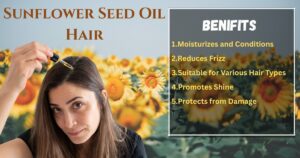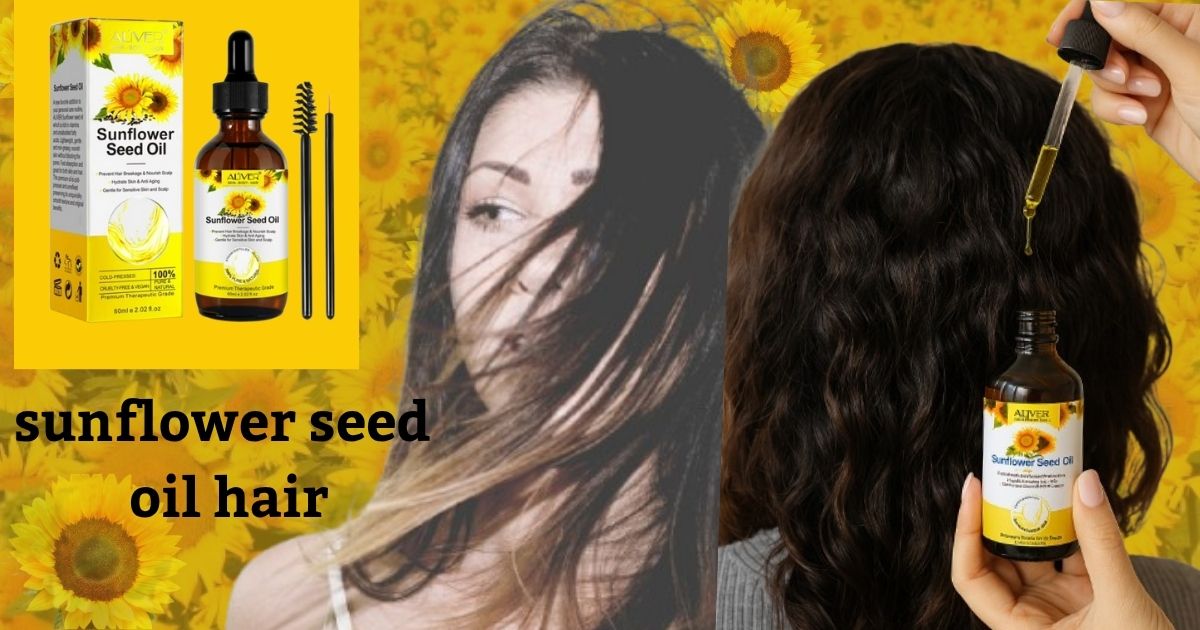Frizz, dryness, breakage — hair problems often trace back to one thing: lack of nourishment.
That’s where sunflower seed oil hair care routines come in.
Packed with vitamin E and essential fatty acids, this underrated oil is a game-changer for anyone craving smoother strands, faster growth, and a healthier scalp.
But not all sunflower oils are created equal — and using it the wrong way can leave your hair greasy or worse, damaged.
In this guide, you’ll learn exactly how to use sunflower seed oil the right way — from expert-approved methods to DIY masks and pro product picks.
No fluff. Just results you can see, starting with your next wash.
Let’s break it down.
What Is Sunflower Seed Oil & Why It Works?
Tired of hair that feels dry, lifeless, or just doesn’t grow like it should?
You’re not alone — and the fix might be hiding in your kitchen cabinet.
Sunflower seed oil is a botanical oil derived from the seeds of the Helianthus annuus plant. But unlike many trendy oils, this one actually delivers results backed by science.
Let’s break down what makes it work — and why your hair craves it.
Sunflower Seed Oil vs. Sunflower Seed Extract
These two ingredients sound similar — but they’re not interchangeable.
Sunflower seed oil is the cold-pressed oil extracted directly from sunflower seeds. It’s rich in essential fatty acids, like omega-6 linoleic acid, and is commonly used as a moisturizing treatment for hair and scalp.
Sunflower seed extract, on the other hand, is usually a water-based ingredient derived from the seeds. It’s processed for antioxidant properties and used in formulated hair care products, often as a supporting agent, not a primary moisturizer.
In short? The oil nourishes and protects. The extract defends and strengthens.
Both have value — but if you’re looking to deeply hydrate, smooth, and protect your strands, pure sunflower seed oil is the hero.
Nutritional Profile: Vitamin E, Oleic & Linoleic Acid
Sunflower seed oil packs a serious nutrient punch.
It’s rich in vitamin E, a powerful antioxidant that supports a healthy scalp and fights free radical damage — a major factor in hair thinning and dullness.
It also contains oleic acid (omega-9) and linoleic acid (omega-6). These fatty acids help lock in moisture, strengthen your hair’s natural barrier, and improve elasticity.
Translation: fewer split ends, more shine, and less frizz — without heavy buildup.
Core Benefits for Hair & Scalp

Sunflower seed oil isn’t just a trend — it solves real problems with real results.
Let’s dive into the top reasons it deserves a spot in your routine.
Reduces Breakage & Promotes Growth
Struggling with slow growth or constant breakage?
Thanks to its high oleic acid content, sunflower seed oil helps stimulate circulation in the scalp, encouraging healthy follicles and faster hair growth.
It also strengthens strands from root to tip — reducing snap-offs and boosting length retention over time.
Controls Frizz & Increases Shine
Frizzy hair thrives on dehydration — sunflower oil stops it at the source.
Its lightweight texture smooths the hair cuticle without weighing it down, making it ideal for fine to thick hair types.
A few drops add instant shine, tame flyaways, and create a polished finish — naturally.
Soothes Dry, Itchy Scalp & Dandruff
If your scalp flakes, burns, or feels tight, it’s likely crying out for moisture.
Sunflower seed oil offers anti-inflammatory benefits that calm irritation while restoring scalp hydration.
It also helps rebalance natural oils, making it a safe option even for those prone to buildup or greasiness.
Protects Color & Heat Damage
Sunflower oil acts like a natural heat protectant, shielding your strands from hot tools and the sun’s UV rays.
Its antioxidant-rich profile forms a barrier that prevents protein loss and fades caused by heat or chemical treatments.
If you color your hair or style with heat, this is your low-cost, plant-based insurance policy.
Ready to see what sunflower seed oil can do in your routine?
Keep reading — the next section shows you exactly how to apply it for maximum impact.
Cold-Pressed vs Refined: Choosing the Right Oil
Not all sunflower seed oils are created equal — especially when it comes to your hair.
The extraction method directly affects the nutritional value, performance, and even safety of the oil you apply to your scalp and strands.
Let’s break down the difference between cold-pressed and refined sunflower seed oil — so you can choose the right one with confidence.
Extraction Methods Explained
Cold-Pressed (Unrefined)
-
Extracted mechanically at low temperatures
-
No chemicals or heat used
-
Retains natural color, scent, and nutrients
Refined
-
Processed using heat and sometimes solvents
-
Removes odor, color, and impurities
-
Produces a lighter oil with longer shelf life
Each serves a purpose — but one is clearly better for hair health.
Cold-Pressed vs Refined: Quick Comparison
| Feature |
Cold-Pressed (Unrefined) |
Refined |
| Nutrient Retention |
High (vitamin E, fatty acids intact) |
Moderate to Low |
| Scent & Color |
Natural scent, golden hue |
Odorless, clear or light yellow |
| Texture |
Richer, slightly thicker |
Light, thin, spreads easily |
| Scalp Benefits |
More effective for dryness, flaking |
Gentle but less nourishing |
| Cost |
Slightly higher |
Budget-friendly |
| Shelf Life |
Shorter |
Longer |
| Best For |
Deep hydration, scalp repair |
Lightweight styling, blending |
Verdict: If you want maximum benefits for hair growth, frizz control, and hydration — go cold-pressed.
Linoleic vs Oleic: Know Your Fatty Acid Profile
Sunflower oils also vary in fatty acid content depending on the seed type:
-
High-linoleic (omega-6): great for hydration, scalp repair, and reducing inflammation
-
High-oleic (omega-9): ideal for shine, softness, and frizz control
Pro Tip: Look for high-linoleic, cold-pressed sunflower oil if your scalp is dry or itchy. Go for high-oleic if your focus is sleekness and styling.
Advice from Real Users
Reddit threads and beauty forums consistently favor cold-pressed, unrefined oil for hair masks and scalp treatments.
A user on r/HaircareScience shared this tip:
“Switched to cold-pressed sunflower oil for my itchy scalp. Instant relief — way better than argan oil for me.”
Another user noted:
“Refined oil is fine for sealing ends, but if you want to nourish your hair, unrefined is the way to go.”
Davines, a professional salon brand, also emphasizes the use of natural, unrefined oils in its botanical formulas for scalp and hair repair.
(source: us.davines.com)
Final Takeaway
-
Choose cold-pressed sunflower seed oil for its full nutrient profile and real hair benefits.
-
Use refined oil for lightweight applications or if you’re scent-sensitive.
-
Check labels for “unrefined,” “cold-pressed,” “high-linoleic”, and avoid overly processed blends.
The right oil makes all the difference. Next, let’s explore how to apply it for maximum results.
How to Use Sunflower Seed Oil for Hair?
Sunflower seed oil only works if you apply it the right way.
Used strategically, it can hydrate your scalp, reduce frizz, and strengthen hair from root to tip. The key is knowing when and how to use it in your routine.
Pre‑Shampoo Scalp Treatment – Massage, Wrap, Rinse
(source: citygrlhaircare.com)
If you struggle with dryness, flakes, or scalp tightness — start here.
Warm 1–2 tablespoons of cold-pressed sunflower oil and apply it directly to your scalp.
-
Massage gently for 3–5 minutes to boost circulation.
-
Wrap your hair in a warm towel for 20–30 minutes.
-
Rinse thoroughly, then follow with your regular shampoo.
This pre-shampoo treatment helps soften buildup and prep the scalp for a deeper clean — without stripping moisture.
Do it once or twice weekly for best results.
Hair Mask Recipes (DIY)
(sources: morroccomethod.com, healthline.com, citygrlhaircare.com)
Sunflower seed oil blends well with other nourishing ingredients to create effective, affordable hair masks.
Hydrating Banana Mask
Blend, apply to damp hair, leave on for 20 minutes, and rinse.
Strengthening Avocado Mask
Perfect for brittle, over-processed hair.
Scalp Scrub with Ground Seeds (source: healthshots.com)
Massage gently into the scalp to exfoliate dead skin and stimulate follicles.
Leave-In Serum for Frizz & Split Ends – Pea-Sized Application
(sources: allure.com, healthline.com, us.davines.com)
Less is more when using sunflower oil as a leave-in.
Rub a pea-sized amount between your palms. Lightly smooth over damp or dry hair — focusing on mid-lengths and ends.
This reduces frizz, adds shine, and seals split ends without weighing hair down. Perfect for thick or curly textures.
Tip: Avoid the scalp unless it’s part of a full treatment. Use sparingly on fine hair.
Conditioner Booster Tip – Mix Into Conditioner
(source: allure.com)
Add moisture without extra steps.
Mix a few drops of sunflower seed oil into your conditioner. Apply as usual, leave in for 2–3 minutes, and rinse well.
This boosts hydration and slip — especially helpful for detangling or co-washing routines.
Heat Protector Spray Method – Diluted Spray for Styling
Use sunflower oil as a natural heat protectant before blow-drying or flat ironing.
-
Mix 1 tsp sunflower oil with ½ cup distilled water in a spray bottle.
-
Shake well before each use.
-
Lightly mist over damp hair before heat styling.
It forms a lightweight barrier that reduces heat damage — especially on color-treated strands.
For extra protection, pair it with a salon-grade protectant like those from Davines or Moroccanoil.
Safety & Best Practices
Even natural oils need careful use. Here’s how to get the benefits without side effects.
Allergy & Patch Test Instructions
(sources: citygrlhaircare.com, healthline.com, augustinusbader.com)
Before full application, do a patch test.
-
Apply a small amount of sunflower oil to your inner elbow.
-
Wait 24 hours.
-
If redness, itching, or irritation occurs — do not use it on your scalp or hair.
Sunflower seed oil is generally well-tolerated, but allergies are always possible.
Avoid Heat Styling Immediately After Oil
(sources: byrdie.com, healthline.com, citygrlhaircare.com)
Do not apply direct heat after a heavy oil treatment.
Oil heats quickly and can damage your strands if not fully rinsed. This applies to blow dryers, flat irons, and curling wands.
Always wash or lightly rinse your hair before using any heat tools.
Use Moderation & Proper Rinse Methods
Using too much sunflower oil can lead to greasy hair and buildup — especially for low-porosity or oily hair types.
Start with small amounts and scale based on your hair’s texture and dryness level.
Rinse thoroughly with warm water and a mild sulfate-free shampoo. Avoid double oiling in the same week unless your hair is highly porous or very dry.
Next up: Product recommendations — find the best sunflower seed oils and blends based on your hair goals.
Top Products & Where to Buy
You don’t need dozens of products to transform your hair — just the right oil in the right form.
Here are the best types of sunflower seed oil products and where to find them.
Cold-Pressed, Pure Sunflower Seed Oils
If you’re looking for the highest nutrient content, go with cold-pressed, unrefined sunflower oil.
These oils retain their vitamin E and fatty acids — ideal for deep hydration, scalp health, and strengthening treatments.
Top Picks:
-
Organic Cold-Pressed Sunflower Oil – Sky Organics: Cosmetic-grade, USDA-certified, lightweight but potent.
-
Now Solutions Sunflower Oil: Affordable, widely available, non-GMO verified.
-
La Tourangelle Cold-Pressed Sunflower Oil (food-grade but cosmetic-safe): Rich in linoleic acid — perfect for scalp massage or pre-shampoo masks.
Where to buy: Amazon, iHerb, Whole Foods, Thrive Market
Blended Oils for Targeted Hair Concerns
Prefer a ready-to-use formula with added actives? Blended oils pair sunflower seed oil with other nourishing ingredients like jojoba, coconut, and argan.
Top Picks:
-
Camille Rose Growth Serum: Combines sunflower, castor, and peppermint oils for scalp stimulation and shine.
-
The Ordinary Multi-Peptide Serum for Hair Density: Uses sunflower oil in a lab-backed growth blend.
-
OGX Nourishing Coconut Milk Anti-Breakage Serum: Infused with sunflower seed extract for added softness and manageability.
Heat-Protectant Sprays with Sunflower Seed Oil
Need styling protection without buildup? Look for thermally stable sprays that use sunflower oil to shield hair from heat.
Top Picks:
-
Harklinikken Leave-In Hair Hydrating Crème (source: harklinikken.eu): Lightweight, non-greasy, and made for heat styling.
-
Verb Ghost Oil: A cult favorite with sunflower oil and moringa to protect, smooth, and defrizz.
-
Bumble and Bumble Hairdresser’s Invisible Oil Heat/UV Protective Primer: Blends sunflower with coconut and argan oils — great for colored hair.
FAQs
Can I use sunflower seed oil on my hair daily?
Yes — but only in small amounts.
For daily use, apply a drop or two to your ends or flyaways. Avoid the scalp unless you’re doing a treatment, as overuse can lead to buildup.
Will it clog pores or cause greasiness?
Not likely, especially if you use cosmetic-grade, cold-pressed sunflower oil.
It has a low comedogenic rating, making it safe for most scalps. Just don’t overapply — especially if you have oily or fine hair.
Is sunflower seed oil safe for color-treated hair?
Absolutely. It’s actually recommended for color protection.
Its antioxidant content helps shield hair from UV rays and heat damage, both of which can fade dye. Use it as a leave-in or part of a heat-protectant spray.
Cold-pressed vs refined — which is better for hair?
Cold-pressed is better if you want more nutrients, moisture, and healing benefits.
Refined oil is lighter and longer-lasting — great for styling but less nourishing overall. Go cold-pressed for treatment, refined for daily smoothing.
Can sunflower seed oil help with hair growth?
Yes — indirectly.
It supports scalp health, reduces breakage, and strengthens follicles. Combined, these effects create the ideal conditions for faster, healthier hair growth.
How long should I leave sunflower oil on my hair?
Leave it on for 20 to 30 minutes for a pre-shampoo treatment. For a deeper mask, up to 1 hour is fine.
If using as a leave-in, keep it minimal and only on the ends.
Conclusion
Sunflower seed oil isn’t just another natural remedy — it’s a proven solution for dry, frizzy, or thinning hair.
Packed with vitamin E, linoleic acid, and antioxidants, it hydrates the scalp, strengthens strands, and adds shine without the heaviness of synthetic products.
Whether you’re using it as a pre-shampoo treatment, mixing it into a DIY mask, or applying it as a lightweight serum — the results speak for themselves.
Start small. Test what works for your hair type. Then build your own routine around it.
Explore the DIY recipes or product picks above to take the guesswork out.
Have a tip or result to share? Drop it in the comments. Want a quick-start guide? Download our usage checklist or browse related tutorials.
Your hair’s next transformation could start with one ingredient — now you know how to use it.
Mahian is our dedicated hair growth and hair oil content writer, with years of experience creating in-depth guides on natural hair treatments, oil applications, and hair care routines. Through extensive research and content creation in the hair growth niche, he has developed a deep understanding of various hair oils, their benefits, and practical usage tips. His writing covers everything from traditional oiling methods to ingredient spotlights, helping readers navigate the world of hair growth solutions. Mahian’s passion for the subject and commitment to thorough research make him a trusted voice for anyone looking to improve their hair health through natural methods.



